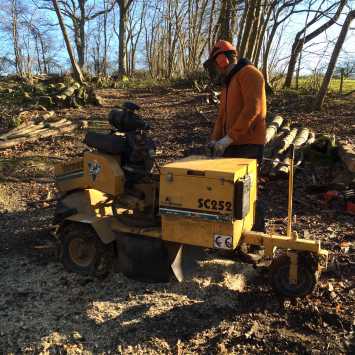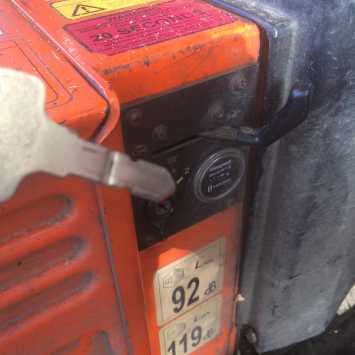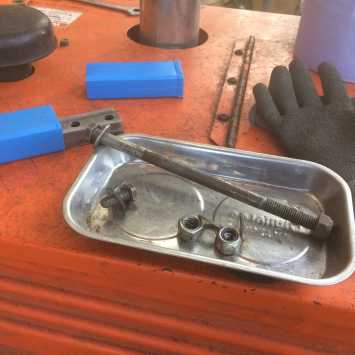A robust and long-serving machine ideal for training
In 2000, we purchased a new Vermeer 252 stump grinder use in our arboricultural contracting business. After 20 years of service, this machine is still going strong. It is mainly used to deliver our popular Lantra Awards Stump Grinder ITA and City & Guilds Unit 220 Level 2 Award in the Safe Use of a Stump grinder IA courses. It does see action occasionally in our contracting jobs.
This article outlines our reasons for selecting this Vermeer machine, the options available when selecting stump grinders and an overview of the typical routine maintenance covered on a training course. A subsequent article details a recent overhaul to the boom hydraulic pipes and jackshaft pulley after a taper lock failure. It links to our recent TP 200 PTO brushwood chipper purchase where we hoped the chipper would have a similar build quality and longevity as the Vermeer has demonstrated over the past 20 years:
- Reliability
- Long lifespan
- Ready available parts from Vermeer UK
- High-quality service from the respective dealers
- Suitability for training courses with a fast learning curve for novices
We used a couple of specialist stump grinder contractors for this service with mixed results before this investment. It always seemed to us that the stump removal fee was out of proportion to the whole job cost, especially when we had a complex rigging removal. In addition, the logistics of getting a contractor to the site promptly or alternatively, storing up a few jobs for more efficient use over a few jobs never seemed to quite work out.
Hoping to get the most out of our prospective purchase, we arranged for a demonstration by Mike Lidster who was working for Vermeer at the time. Mike said he believed in offering a comprehensive demo, and we perhaps took this to the extreme by fitting in 3 stump grinding jobs we had accumulated locally and in the process covering the first six months of finance payments.
We chose this machine because of the build quality and relatively high power within a compact unit capable of accessing most of our client’s tree stumps. Here we outline the primary considerations in making that choice looking at the five mainstream UK options:
- Pedestrian - manual movement of cutting head
- Self-propelled - hydraulic movement of cutting head
- Tracked
- Tractor mounted PTO
- 360 Excavator mounted
Pedestrian machines with manual head movement tend to be the most popular machine option. This is because of the relatively easy transportation to and from the sites and its excellent accessibility due to compact dimensions and lower weights. Combined with ramps, they can cope with level changes and modest steps typical in many smaller garden situations. Many machines are being made, so they tend to be quite competitively priced and are available in a range of power units, often around 20-30hp. The downside here is that significant physical effort is required to move the cutting head, and most machines pivot in cutting mode by locking the drive axel - this often creeps backwards and can be a cause of frustration leading to misuse.
Pedestrian machines with hydraulically powered head movement such as the Vermeer 252 are also popular for many of the above reasons, albeit they are generally slightly more powerful, heavier and expensive. Accessibility can still be good, and our machine has an optional dual-wheel configuration, giving much-improved stability mitigating a significant drawback of this machine type – high centre of gravity. A high engine mounting, the boom swinging into a low position on a slope and sometimes the pull created by an incorrect advance onto the stump can combine and lead to a dangerous overturn.
Tracked machines offer apparent benefits in site accessibility and manoeuvrability and can bring a welcome reduction in manual handling than the smaller pedestrian machines. The remote control may be offered an option; as a minimum, this separation in operator and machine results in eliminating the harmful vibration transmission. It may also allow the operator to gain an enhanced view of the cutting head and progress and move them further away from the trajectory of the arisings, which is generally under and to the sides.
Drawbacks to tracked machines would be their significant mass, and transportation implications as a trailer are often utilised. Loading and unloading any stump grinder is a frequent cause of accidents; it’s well worth checking the maximum recommended gradients as they are often a loss, like a lot less than you would expect.
Tractor mounted machines or PTO stump grinders need a power source so that a pre-requisite would be on the available tractor. They are as manoeuvrable as the tractor they are coupled to. They’re relatively low cost and take up less space for storage overall. It’s less practical to coordinate a tractor-mounted machine for all but the most local site work, although faster tractor units can go some way to mitigating this drawback. In short, it's ideal for large stumps in a parkland setting.
Excavator mounted stump grinders are powered by the base machines hydraulic circuit via additional service pipes and the stump grinders motor. The grinding wheel rotates away from the operator position; hence most of the debris arising is thrown away from the cab. They would be an ideal choice for those already utilising an excavator base machine for other tasks and give a comfortable, safe operator position when adequately guarded. Overturn risk is still present but is for the whole machine. Perhaps there is less precise control or finesse, making this combination more suited to site clearance jobs.
Vermeer 252 in use and maintenance overview
In use, the machines Kohler 25hp V twin engine provides a reasonable level of power, although more recent equivalents often have another 10hp or so.
3 main hydraulic controls make the machine move forward or backward, the cutting head up or down and the head left to right. The auto sweep cuts in to minimise stress on the machine when more rigid material is encountered with an engine speed sensor controlling a hydraulic flow valve to the side sweep speed. Also, ground speed can be adjusted (hydraulic oil flow valve) to fast for major on-site repositioning or to slow for stump grinding advance and retreat.
The rest of the hydraulic system comprises a tank protected in the control box, pump is driven from a v belt off the engine crankshaft engaged by an electromagnetic clutch, control valves and distribution pipes. Students can readily see and understand the drive mechanism, as the cutter wheel belt and jackshaft belts are protected via simple metal guards.
Original equipment finger cutters (6 x left, 6 x right and 4 x straight) are secured by robust pocket and allen bolts. The heavy-duty cutter wheel is supported on two main bearings that can wear over time if not lubricated correctly - remember, too much grease can cause seals to fail and advance bearing wear.
This all adds up to a capable machine that most people could master after a few days use to get up to a productive work rate. Maintenance is straightforward and detailed below:
Overall condition based on walk round inspection - focus on
- Structure of chassis - not rusted, bent or loose sections
- Controls & safety features, warning decals location & condition
- Guards - location & condition
- Cutting mechanism - sharp, secure and complete
Power transmission:
- PTO shaft - between each set of pulleys
- Belts
- Pulleys
- Bearings
Hydraulic system:
- System overview & component location
- Oil level & topping up specification
- Hose condition & leaks
- Motor & Valve condition
- Ram condition & end lubrication (if relevant)
Engine checks:
- Engine oil - level & condition
- Coolant - level
- Air filter - inspection & cleaning
- Drive belts - condition & tension
- Electrical system - visual checks
- Exhaust - visual checks for leaks and gasket/stack damage
- Fuel system - component location and visual checks for leaks
- Engine air intake on larger tracked machines
- If towing - road legalities - tyres, lights, number plates & driver licencing




